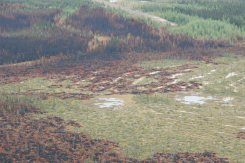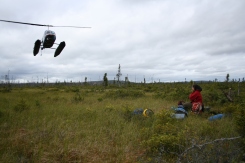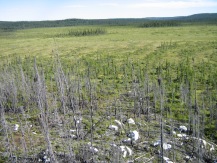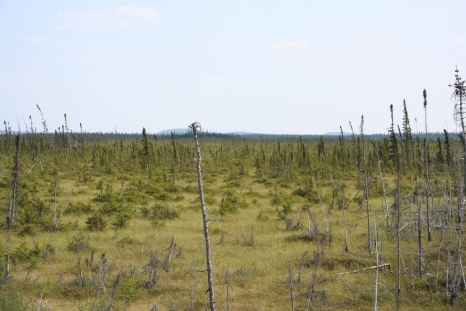This
is a collection of articles that provides some context to the
wildfires in Alberta – something sorely missing from the media
discussion that fails to even tell us that Fort McMurray is situated
in the tar sands area of Alberta, that this is conencted to
unprecedented heat caused by disruption of the jetstream, a major
symptom of abrupt climate change.
Join
the dots.
****
“According
to the authors, their observations of carbon loss from the Anaktuvuk
River fire support the idea that tundra fires have the potential to
release large amounts of carbon and decrease landscape carbon stocks,
having an immediate impact on atmospheric carbon and climate.”
Largest
recorded tundra fire yields scientific surprises
This
NASA MODSIS image of the North Slope of the Brooks Range in Alaska
shows the Anaktuvuk River fire scar in the lower right quarter of the
image. Credit: NASA/GSFC, MODIS Rapid Response
27
July, 2011
In
2007 the largest recorded tundra fire in the circumpolar arctic
released approximately as much carbon into the atmosphere as the
tundra has stored in the previous 50 years, say scientists in the
July 28 issue of the journal Nature. The study of the Anaktuvuk River
fire on Alaska's North Slope revealed how rapidly a single tundra
fire can offset or reverse a half-century worth of soil-stored
carbon.
Tundra
soils store huge amounts of carbon hundreds to thousands of years
old. Intact, the layers of organic soil insulate the permanently
frozen ground, called permafrost, below.
"Fire
has been largely absent from tundra for the past 11,000 or so years,
but the frequency of tundra fires is increasing, probably as a
response to climate warming," said co-author Syndonia "Donie"
Bret-Harte, an ecosystem ecologist at the University of Alaska
Fairbanks Institute of Arctic Biology.
The
Anaktuvuk River fire burned 1,039 square kilometers (401 square
miles), an area roughly the size of Cape Cod and visible from space,
and released more than 2.1 teragrams (2.3 million tons) of carbon
into the atmosphere. Radiocarbon dating of the soils revealed the
maximum age of the soil carbon emitted from the fire was 50 years.
"The
amount of carbon released into the atmosphere from this fire is
equivalent to the amount of carbon stored by the global tundra
biome," said lead author Michelle Mack, a biologist from the
University of Florida. "This was a boreal forest-sized fire."
Little
is known about the effects of fire on carbon storage and cycling in
tundra ecosystems. Cool, wet soils underlain by permafrost are
thought to restrict fires to aboveground plants and ground-level
plant litter leaving the carbon stored in soils relatively intact. As
arctic summers get warmer and dryer, so too do the soils, which are
highly flammable and able to burn more deeply when dry.
"If
the frequency of these fires remains at long intervals, 80 to 150
years, then the tundra has time to recover," Bret-Hart said. "If
these fires occur more frequently, say every 10 years or so, then the
landscape cannot recover."
The
Anaktuvuk River fire was started by a lightning strike in July 2007.
"Normally we would expect the fire to go out in the moist soil,
but this summer was so dry that the fire didn't go out and strong
winds in September caused it to burn a very large area," said
Bret-Harte, who noted that 40 percent of the fire was classified as a
severe burn – high for a tundra fire. The fire was visible 24
kilometers south at the IAB Toolik Field Station, where the
scientists were working, as a wall of smoke on the horizon.
In
addition to the direct release of carbon into the atmosphere, tundra
fires are important because of the potential feedbacks to global
climate change. "These fires could be a radical and very rapid
positive feedback to atmospheric carbon dioxide," said Mack.
Fire
removes organic material that insulates permafrost from warm summer
temperatures. Insufficient insulation can lead to thawing permafrost,
destabilization of the ground surface and exposure of deep soil
carbon to decomposition and release into the atmosphere –
ultimately amplifying high-latitude warming.
According
to the authors, their observations of carbon loss from the Anaktuvuk
River fire support the idea that tundra fires have the potential to
release large amounts of carbon and decrease landscape carbon stocks,
having an immediate impact on atmospheric carbon and climate.
Provided
by: University of Alaska Fairbanks

Greenpeace
warns fires raging across forest and peatlands will match the worst
year ever and exceed the total annual carbon output of the UK
Fires
raging across the forests and peatlands of Indonesia are on track to
pump out more carbon emissions than the UK’s entire annual output,
Greenpeace has warned.
As
well as fuelling global warming, the thick smoke choking cities in
the region is likely to cause the premature deaths of more than
100,000 people in the region and is also destroying vital habitats
for endangered orangutans and clouded leopards.
New
drone video footage from Greenpeace from around the Gunung Palung
national park in Kalimantan shows the peat fires smouldering
underground, as well as flames burning down trees, and the thick haze
they produce.
There
have been almost 10,000 fires in the last month across Kalimantan
(Indonesian Borneo) and Sumatra, with the drifting smoke also
provoking protests from neighbouring Malaysia, Singapore and
Thailand......
The
record forest and peat fires of 1997 produced huge carbon emissions,
estimated by scientists at between 0.81 and 2.57 gigatonnes (Gt),
equivalent to 13-40% of the entire world’s annual fossil fuel
emissions. It lead to the biggest annual jump in CO2 ever recorded.
By comparison, the UK’s carbon emissions for the whole of 2014 were
0.52Gt.
The
health impact of the forest and peat fires is also expected to be
large, with the resulting premature deaths across south-east Asia
estimated at 110,000 deaths in an average year. More than 75,000
people are already suffering from upper respiratory infections as a
result of the haze, according to media reports.

Indonesia's peat fires make it the 4th-largest carbon emitter in the world
"The
McMurray Formation is a stratigraphic unit of Early Cretaceous age
(late Barremian to Aptian stage) of the Western Canada Sedimentary
Basin in northeastern Alberta.[3] It takes the name from Fort
McMurray, and was first described in the outcrops exposed along the
banks of the Athabasca River, 5 KILOMETERS (3.1 mi) north of Fort
McMurray, by F.H. McLearn in 1917.[4] It is a well-studied example of
fluvial to estuarine sedimentation, and it is economically important
because it hosts most of the vast bitumen resources of the Athabasca
Oil Sands region."
Danger
map shows 'extreme' risk of fires in both provinces
As
tens of thousands of residents flee from
Fort McMurray, Alta., the threat of more fires
continues to loom across Alberta and Saskatchewan.
On
May 4, Natural Resources Canada indicated that the risk of fire is
"extreme" in the two provinces.
A
map the federal department produced for Wednesday shows a huge red
zone over most of the region.
The Canadian Wildland Fire
Information System is
a computer-based system that monitors fire danger conditions across
Canada.
The
system creates a fire danger map based on daily weather conditions
such as temperature and humidity.
It
also takes into consideration factors like how easy it is to
ignite vegetation, how difficult a fire may be to control, and how
much damage a fire can do.
British
Columbia has turned down a request for help from Alberta to send
firefighters to help battle the Fort McMurray blaze, as the province
struggles with an early start to this year’s wildfire season.
Ryan
Turcot, an information officer with the B.C. Wildfire Service, said
Alberta made a request for help Tuesday through the national Canadian
Interagency Forest Fire Centre. Requests go to all provinces and
territories, so that those jurisdictions experiencing lower levels of
activity can lend resources if available.
But
B.C. is currently experiencing high levels of fire activity,
especially in the Peace River Region, where more than 50 fires are
burning and five evacuation alerts are in place. “Our personnel are
currently fully engaged across the province,” said Turcot, in an
email Wednesday morning.
“Given
the current level of fire activity in B.C, and the need to maintain
necessary resources here, B.C. was unable to lend crews at this time.
Future requests will be considered,” he said.
“Smouldering
peat fires already are the largest fires on Earth in terms of their
carbon footprint,”explained mega-fire
expert Prof. Guillermo Rein last week.
He
is coauthor of a new
study called
“Global vulnerability of peatlands to fire and carbon loss,”
which warns that massive, difficult-to-stop peatland fires are likely
to become even larger in the future, as human activity keeps drying
out the formerly wet peatlands.
Since
a key reason many peatlands will become drier is global warming, and
since peatland fires can release staggering amounts of carbon
dioxide, this process is a vicious circle, a dangerous amplifying
carbon cycle feedback.
From
Indonesia to Botswana, from Scotland to North Carolina, peat
mega-fires burn for months, destroy habitat, clog the air with haze,
and self-accelerate climate change impacts.
Smouldering
combustion is the slow, low temperature, flameless burning of porous
fuels. It is especially common in wildland fuels which are thermally
thick and form a char on heating. In the natural environment,
smouldering fires burn two types of biomass: thick fuels like tree
branches or logs, and organic soils like the duff layer or peat.
These are characterized by having a significantly greater thermal
time compared to fine fuels like foliage. The persistent smouldering
of thick fuels is typically observed for a few days after a flaming
wildfire has passed, and it is often referred to as residual
combustion. This can make residual smouldering be responsible for the
majority of the biomass burned during a wildfires.
PEATLANDS UNDER FIRE!
by Simon
van Bellen
·
21
February, 2014
Can
pristine, undrained bogs burn? Looking at the soggy surface
conditions of most northern peatlands, it may be hard to believe
that, even in a natural state, they can actually burn. Perhaps it is
even more surprising to learn that the ones that can burn most
frequently and severely are located in the colder regions of the
global peatland distribution
The
peatlands of North America form a major part of the global peatland
area, comprising about a third of the global peatland carbon pool.
Many North American peatlands are located in boreal forests,
where coniferous trees dominate the landscape. Since the onset of the
Holocene, these peatlands have developed over millennia under
continental climate conditions: relatively warm summers and cold,
harsh winters with low precipitation. As a result of these extreme
climate conditions, peat accumulation is limited to a growing season
of only a few months and in the northern parts, patches
of permafrost may
occur in the form of peat palsas.
In the coniferous forests surrounding the boreal peatlands, fires are
frequent and intense and, more often than not, ignited by lightning.
The occurrence of fires may be explained by the dry, warm summers,
but also because of specific tree adaptation: jack pine (Pinus
banksiana)
and to a lesser extent black spruce (Picea
mariana)
need the intense heat for seed release and regeneration.
The
Canadian boreal peatland zone runs from eastern to western Canada.
Going westward, climate becomes generally drier and the peatland
vegetation cover changes from open Sphagnum bogs
with shrubby hummocks and wet hollows in Quebec, to spruce-covered
bogs in northern Alberta. Although forest fires are frequent in the
entire Canadian boreal zone, peatlands are affected more frequently
in western Canada because of the differences in vegetation cover. In
the western part, peatlands have burned as frequently as the
neighbouring uplands during the last couple of decades.
Fires
directly release carbon to the atmosphere by combustion, but they
also influence the functioning of the ecosystem in the long term.
Fire and charcoal production alter the soil microclimate and
microbial populations (e.g. testate
amoebae)
and therefore respiration dynamics. As fires may burn live vegetation
and/or litter as well as peat, thecarbon
balance of
the peatlands is negatively influenced by recurrent fires. About 3 kg
of carbon per metre squared can be released from a peat bog per fire
in western Canada, which means that under the current climate
conditions these bogs are only small net sinks of carbon. With
ongoing climate change and more peat being burned, these bogs may
even become net sources in the near future.
The
situation is somewhat different in eastern Canada. During my Ph.D.
research atUniversité
du Québec à Montréal,
I analysed peat cores from three open bogs from the Eastmain region
in the heart of the spruce-dominated boreal forest, searching for
evidence of peat burning and possible effects of varying fire regimes
on peat carbon sequestration during the Holocene. In short, peat
burns here too. However, peat fires are much less frequent than in
western Canada and do not seem to affect the deeper peat. Therefore,
fire has been a minor factor in the development of these peatlands,
especially when compared to other external variables, of which
Neoglacial cooling may have been the most important one.
Burning
patterns can be highly variable at the ecosystem scale as well. In
sites with micro-topographical features, hollows generally lose more
organic matter by combustion than hummocks. The explanation for this
lies in the nature of the hollow vegetation. During dry periods,
hollows dry out much more rapidly than hummocks, because of the
‘loose’ nature of the Sphagnum species
found here and their low potential for water retention, while the
dense Sphagnum cover
of hummocks retains humidity more effectively. Therefore, in these
peatlands, hollows tend to burn more deeply.
Looking
at the complex spatial and temporal patterns of peat fire occurrence,
it may seem difficult to forecast peat fire regimes with ongoing
climate change. In general, larger areas of forest will be affected
and fire occurrence and fire season length are anticipated to
increase for most of the Canadian boreal regions. One could argue
that if forest fires become more frequent, peatlands too may burn
more often. However, the sensitivity of peatlands to burning may not
depend on the same meteorological variables that determine the
sensitivity of forest stands. Alternatively perhaps, peatland
vegetation, rather than weather, may be a critical factor. Either
way, the fire regimes of boreal peatland regions are likely to become
an increasingly important factor in the estimation of future carbon
fluxes from natural sources.
Further
reading:
de
Groot, W.J., Flannigan, M.D., Cantin, A.S. (2013) Climate change
impacts on future boreal fire regimes. Forest Ecology and Management
294: 35-44.
Turetsky,
M., Wieder, K., Halsey, L., Vitt, D. (2002) Current disturbance and
the diminishing peatland carbon sink. Geophysical Research Letters
29. doi:10.1029/2001GL014000.
Yu,
Z. (2012) Northern peatland carbon stocks and dynamics: a review.
Biogeosciences Discussions 9: 5073–5107
The
worst U.S. mine fire, in Centralia, Pennsylvania, passed its 50-year
mark last year. As coal-powered development spreads globally, so does
the risk of underground fire.
The
Centralia blaze, still burning more than 50 years after it began,
ranks as the worst mine fire in the United States. But it is by no
means the only one. More than 200 underground and surface coal fires
are burning in 14 states, according to the U.S. Department of
Interior's Office of Surface Mining Reclamation and Enforcement.
And
with worldwide demand for coal surging, especially in industrializing
nations such as India and China, mine fires have emerged as a global
environmental and public health threat. Thousands of coal fires rage
on every continent but Antarctica, endangering nearby communities.
The blazes spew toxic substances such as benzene, hydrogen sulfide,
mercury, and arsenic, as well as greenhouse gases like methane and
carbon dioxide.
Final word from Sam Carana -
Final word from Sam Carana -
Wildfires
in the North threaten to cause large emissions of greenhouse gases
and soot, which can settle on snow and ice in the Arctic and the
Himalayan Plateau, with the resulting albedo changes causing a lot
more sunlight to be absorbed, instead of reflected as was the case
earlier.
This in turn adds to the problem.
Additionally, rising
temperatures in the Arctic threaten to cause release of huge amounts
of methane from sediments below the Arctic Ocean.
This situation
threatens to escalate into runway global warming in a matter of years
--SAM
CARANA



















No comments:
Post a Comment
Note: only a member of this blog may post a comment.